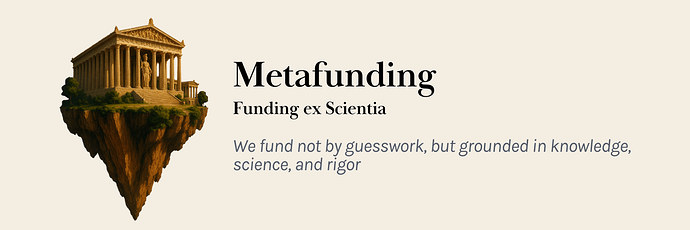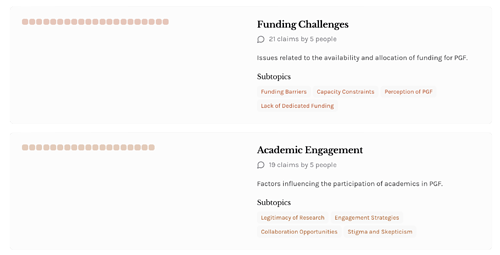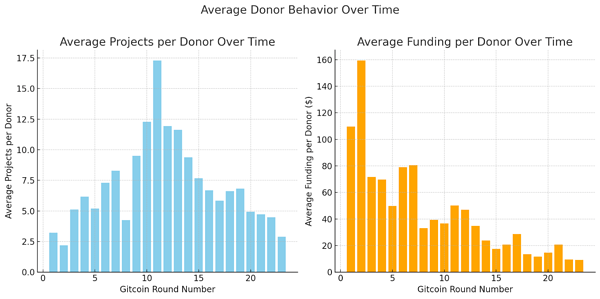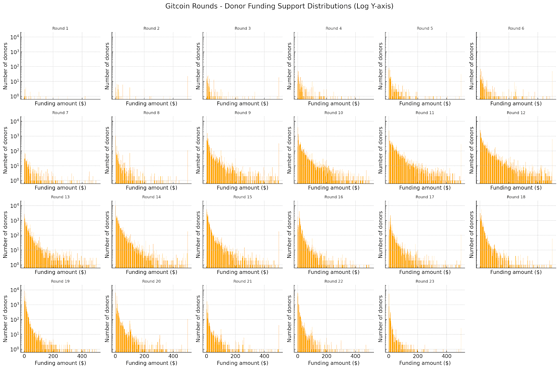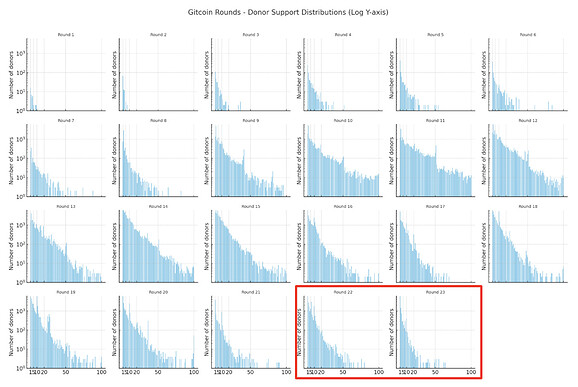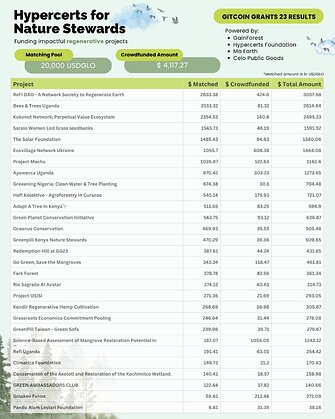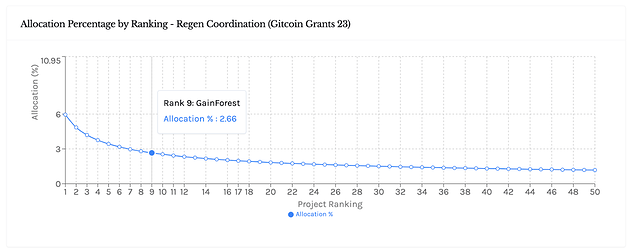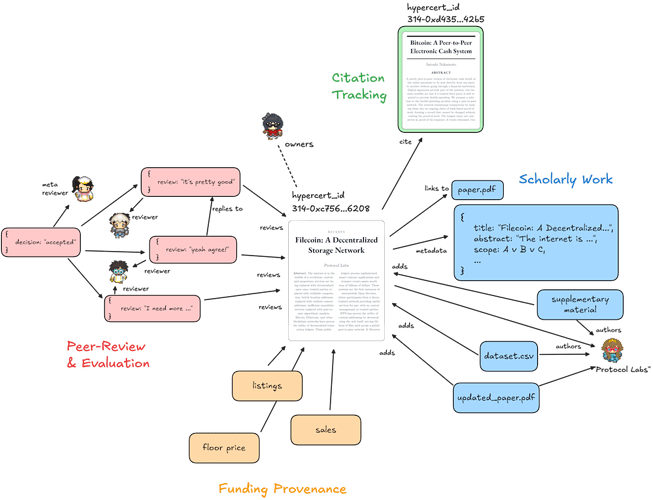Metafunding: Fund PGF Mechanisms & Research
By GainForest.Earth, Funding the Commons, Hypercerts Foundation, Seer One and the Recerts Editors Collective
Tl;dr (slightly  )
)
Ethereum’s future hinges on elevating PGF into a high-ROI. The Metafunding domain will explore how to fund Ethereum forever by finally establishing academic rigor and feedback signals. In this report, we gathered millions of data points to show why we have to stop the PGF guesswork and subsequently propose to use a peer-reviewed hypercert mechanism to create healthy research feedback loops/reflections for PGF from crypto and academic experts - aiming to change the PGF narrative from guesswork charity to essential infra.
One Minute Summary
Ethereum’s long-term health depends on the sustainability and effectiveness of its Public Goods Funding (PGF) mechanisms — systems like Quadratic Funding and RetroPGF that allocate resources to the infrastructure, tools, and communities the ecosystem relies on. While these models have proven their potential in catalyzing growth and strengthening resilience, adoption and impact remain constrained by systemic challenges: PGF is often perceived as charity rather than high-ROI investment, there is little formal academic engagement to validate or improve designs, data quality is insufficient for robust analysis, and evaluator capacity limits scale and credibility. Without dedicated research and infrastructure, PGF risks becoming a series of isolated experiments with diminishing engagement, as recent Gitcoin trends show. Metafunding proposes to address this by creating a Gitcoin Grants domain devoted to the rigorous study, refinement, and scaling of PGF mechanisms. Leveraging a mechanism that is inspired by academic peer-review, the initiative will aim to bridge academia and crypto, generate open datasets, and establish the evaluation capacity needed to turn PGF from a niche experiment into a trusted, scalable funding layer for Ethereum and beyond.
Advancing the Science of Funding Public Goods in Ethereum and Beyond
What specific Ethereum problem are you addressing? Why is this urgent and significant right now? What evidence supports the importance of this problem?
Public Goods Funding (PGF) — mechanisms that allocate resources to open-source infrastructure, shared knowledge, and community services — is one of Ethereum’s most important experiments. Yet, despite years of pilots, progress remains rate-limited.
The stakes are high: PGF mechanisms like Quadratic Funding, Retroactive Public Goods Funding, and mechanism design experiments have shown they can catalyze ecosystem growth, improve infrastructure security, and strengthen communities. Similar to how national governments fund science, education, and infrastructure to maintain a thriving society, Ethereum’s long-term health depends on sustaining the mechanisms that keep its commons strong. The problem is not unique to crypto — globally, public goods have always been underfunded due to the free-rider problem — but in crypto, we have the opportunity to design and deploy new, scalable solutions.
As Kevin Owocki puts it:
“We need a ‘Uniswap of PGF’ — a breakout success that proves it can work at scale. Right now, it’s a chicken-and-egg problem: no funding, no talent; no talent, no funding.”
Why Metafunding Matters
PGF is the “funding layer” for everything Ethereum cares about — protocol security, developer experience, user adoption, ecosystem resilience. Well-designed funding mechanisms have a multiplier effect: they make every funded project more impactful by allocating capital more effectively.
Metafunding research is the science of improving these mechanisms — studying incentives, allocation models, evaluator capacity, and governance structures so that we can fund better, faster, and with more rigor.
In traditional contexts, public goods are often financed through taxation, philanthropic grants, or multilateral institutions pooling resources to address global challenges. In crypto, DAOs and decentralized treasuries now play this role, experimenting with models like quadratic funding and retroactive rewards. These crypto-native mechanisms are promising, but they remain niche and are often misunderstood outside Web3. To make them mainstream, we need the kind of rigorous evaluation, bridge-building, and usability improvements that took decades in traditional public finance.
Right now, the PGF space faces systemic constraints:
- Perception Problem: PGF is still seen as “charity” or a cost center, not as an investment in ecosystem value growth. In the corporate and government world, public goods are funded when they’re tied to visible ROI — like infrastructure that drives trade or research that fuels innovation. We need that same framing for crypto PGF.
- Academic Gap: Few researchers work on PGF because it’s not recognized as a formal academic category and there’s no structured, recurring funding to support it. In other domains, major breakthroughs have come when research funding became predictable and prestigious; PGF is nowhere near that point.
- Data Deficit: Economists and mechanism designers require high-quality, longitudinal datasets to run meaningful studies. Without standardized metrics and open data, PGF design remains guesswork.
- Evaluator Bottleneck: Large-scale public goods funding depends on credible, skilled evaluators — and right now, there are too few people with the expertise to review mechanisms or projects at scale.
- Narrative Weakness: Mainstream funders lack credible metrics to prove that PGF mechanisms lead to better, fairer, or more impactful allocation of resources compared to traditional grants.
As Raymond Cheng from OSO notes:
“We’re not bottlenecked by financial rails or more web apps. We’re bottlenecked by making the case for why PGF is important and why it works — and doing the analysis to prove it.”
Read the full BroadListening report here.
Figure 1: Broad Listening detects common challenges through our interview with thought leaders in the PGF space
Problem Statement
Without targeted research funding in metafunding, Ethereum risks:
- Running PGF experiments without knowing which works best or why.
- Missing opportunities to integrate PGF into ecosystem growth strategies.
- Failing to attract serious academic engagement from economics, political science, and mechanism design.
It’s about funding the mechanisms that fund the projects. Without dedicated investment in mechanism research, we risk a patchwork of small experiments without the scale, legitimacy, and impact needed to sustain Ethereum’s commons.
PGF needs rigorous reflection — and the data shows it
Who are our donors and what are they doing?
For this sensemaking report, we have analyzed 5.2 million individual Gitcoin donations over 23 rounds from Open Source Observer to show that our PGF mechanisms are not well understood and that more rigorous experiments and science are urgently needed.
Figure 2: Gitcoin rounds have seen less engagement and donations over time
Why have Gitcoin donors been giving less and less funding since Round 2? Why are the average PGF donors in Gitcoin supporting fewer and fewer projects, leading to a centralization of funding? This is a trend that we believe needs to be better understood.
Figure 3: The funding behaviour of average Gitcoin donors has changed (in log scale). There is a consistent trend showing a decrease in average donation amounts over the years.
Additionally, since the introduction of COCM in GG22, single-project-donors are programmatically excluded from being counted into the matching fund. And still, in GG22 and GG23 we have seen the highest number of single-project donors in Gitcoin’s history. Thus, we either don’t communicate sufficiently to our donor basis, or something is off. Empirically, there is a disconnect between our mechanisms and our donor basis.
Figure 4: The number of projects supported per donor (in log scale). Single-project-donors have been programmatically excluded from the matching calculation by COCM since GG22 (in red) but they have never been higher in Gitcoin’s history than in the last two GG rounds. Why??
In traditional public finance, such disconnects between funding rules and participant behavior are often caught and corrected by institutional research arms. Ethereum’s PGF ecosystem needs that same capacity for continuous measurement and course correction.
Who are our funders and what are they thinking?
To complement our analysis of donor behavior, we examined the values and priorities that funders themselves bring to public goods funding decisions — the beliefs that ultimately shape how mechanisms perform in practice. Using a Polis survey with 109 participants, we invited respondents to propose, agree, and disagree on key principles for allocating public goods funding. The results reveal a striking plurality of funder ideologies, with significant divergence across clusters in what should be prioritized — from measurable outcomes and geographic equity to innovation, governance, and sustainability.
Figure 5: Statement with most consensus among all participants
Figure 6: Statement participants disagree the most
The visualization above shows the distribution of agreement, disagreement, and neutrality for each statement, broken down by overall responses and by cluster. Some statements, such as prioritizing projects that benefit the greatest number of people or supporting sustainable revenue models, drew broad consensus. Others, like prioritizing immediate community needs over long-term systemic change, split respondents sharply along ideological lines.
This diversity of funder values underscores that improving PGF needs mechanisms that can perform well across a heterogeneous, and sometimes conflicting, set of priorities. By embedding research, live experimentation, and structured evaluation into Gitcoin, Metafunding will provide the evidence, iteration cycles, and communication tools needed to design PGF systems that are both technically sound and socially legitimate across this spectrum of funder worldviews.
Full Polis report available here.
Sensemaking Analysis
What sensemaking tools did you use? What sources did you use for this analysis? How did you aggregate your data/findings?
For this report, we combined qualitative broad listening with quantitative behavioral and attitudinal analysis to understand the systemic challenges facing Ethereum’s Public Goods Funding (PGF) mechanisms.
- Our primary qualitative tool was Broad Listening (see broadlistening.org), a methodology developed through the work of Audrey Tang to detect recurring patterns, shared concerns, and divergent perspectives across diverse stakeholders.
- On the quantitative behavioral side, we analyzed 5.2 million individual Gitcoin donation records spanning 23 rounds, sourced from Open Source Observer (OSO) using python scripts and BigQuery. We used time-series analysis to track trends in donor engagement, average projects supported per donor, and donation size distributions.
- To capture the landscape of funders, we conducted a Polis (see pol.is) survey with 109 participants, asking them to propose, agree, and disagree on values that should guide public goods funding.
Our Proposal
Metafunding will run as a Gitcoin Grants domain focused on transforming PGF from guesswork to evidence-based infrastructure. The domain will:
- Advance Mechanism Science: Formalize and understand experiments on PGF designs (e.g., budget constraints, matching pool composition, retroactive criteria) and evaluate their outcomes.
- Bridge Academia and Crypto: Create structured pathways for economists, political scientists, and computer scientists to contribute to PGF research and collaborate with Ethereum builders.
- Establish ROI Evidence: Produce policy reports, case studies, and metrics that demonstrate PGF’s return on investment — reframing it as essential infrastructure rather than charity.
- Build Open Data Infrastructure: Develop standardized datasets, metrics, and citation networks so PGF research compounds over time.
- Integrate With Ethereum Practice: Ensure findings are adopted by DAOs, foundations, and funders, turning insights into live governance and funding strategies.
How the Round Will Work: Peer-Reviewed Hypercerts Funding
Figure 7: Scholarly Hypercerts (Recerts) Peer-Review with Virtual Reviewers and Real Reviewers
- Submission
- Researchers, mechanism designers, and data builders submit PGF-related work (studies, papers, datasets, mechanism proposals). We are aiming for more than 20 submissions in October. The three most promising submissions by academics receive fully funded builder’s residency spots at Funding the Commons.
- Contributions are minted as scholarly hypercerts via Recerts.org or Hyperstaker.com, creating a transparent and auditable record.
- Editorial Screening
- An editorial board vets submissions for relevance and baseline quality.
- Accepted work proceeds into structured peer review.
- Peer Review & Evaluation
- Expert peer reviewers assess submissions for rigor and impact.
- Digital twin reviewers via Simocracy.org provide benchmark scores to test consistency and bias.
- Prediction markets via Seer.pm allow participants to forecast which work will prove most impactful, adding a collective intelligence layer.
- Funding Allocation via Hypercert Purchases
- Instead of distributing grants, funds are allocated by purchasing the hypercerts representing claims on the research contributions.
- This channels capital directly to the most credible and impactful work, while creating tradable, auditable proof of support and future impact claims.
- Knowledge Tracking
- Hypercerts record citations, references, and derivative work, building a cumulative and auditable record of PGF research.
- Open data and citation networks ensure new contributions compound on past insights.
Why Peer-Reviewed Hypercerts Funding?
These tools mirror the peer-review and evaluation infrastructure found in academia and traditional development — but adapted for the speed, transparency, and openness of crypto ecosystems. Peer review is particularly well-suited to PGF because it provides a structured, merit-based way to assess complex proposals, balance diverse perspectives, and justify funding decisions in a transparent manner. In traditional contexts, this process has been key to sustaining trust in how public resources are allocated, ensuring that funding flows to the most credible, impactful work. In Ethereum’s PGF ecosystem — where mechanisms are still earning legitimacy and community trust — peer review can serve the same role, while also enabling rapid iteration and broad participation.
Hypercerts and Simocracy: Tools with Proven Traction
Recerts (recerts.org) – a fork of Ecocert Hypercerts (ecocertain.xyz) – and Hyperstaker (hyperstaker.com) – building on the established Hypercerts protocol – have found traction in GG23’s Hypercerts for Nature Stewards round, which raised $4,117.27 for 29 projects with a $20,000 matching pool. We believe scholarly hypercerts (recerts) enable transparent, impact-verified research records, making it easy to track contributions and citations across PGF studies.
Figure 8: Results from the Hypercerts round in GG23 Announcements | Hypercerts
Simocracy (simocracy.org) is the second iteration of the DeepGov mechanism and is purpose-built for democratic qualitative evaluation at scale. In GG23, DeepGov engaged hundreds of participants, recorded 49 unique votes in quadratic voting (vote.deepgov.org), and distributed $50,000 on top of existing GG23 rounds. It was successfully used by:
- ImpactQF Regen Coordination
- Hypercerts for Nature Stewards
- OSS Dapps & Apps round
- OSS Infra round
- OSS DevTooling round
Figure 9: Results from the DeepGov round with Regen Coordination in GG23 https://allo.deepgov.org
Gitcoin’s Unique Role
How can Gitcoin uniquely help solve this problem? Why does a network better solve this than by existing organizations?
Gitcoin is uniquely positioned to host and scale Metafunding because it is both one of Ethereum’s most established platforms for public goods funding and one of its most active laboratories for mechanism design. This concentration of mechanism designers, funders, builders, and researchers allows theoretical advances to be tested in live experiments and quickly integrated into practice, while Gitcoin’s scale and reputation give resulting research legitimacy with developers, funders, and policymakers. Unlike traditional institutions, Gitcoin can launch and iterate mechanisms within weeks, enabling rapid cycles of experimentation and improvement. By embedding Metafunding here, Ethereum gains a self-reinforcing feedback loop in which Gitcoin runs experiments, research refines mechanisms, improved PGF design boosts the impact of all funded projects, and stronger results attract more funders, ultimately making Gitcoin not just a funding hub but the research and development arm of Ethereum’s public goods ecosystem.
- Mission Alignment: Gitcoin exists to fund public goods — metafunding research is the meta-layer of that mission.
- Network Effects: Gitcoin’s community includes PGF mechanism designers, ecosystem funders, and applied researchers.
- Mechanism Innovation: Gitcoin can pilot and iterate novel funding models faster than hierarchical institutions.
Success Criteria
What specific outcomes will show success within 6 months? How will we measure genuine impact beyond just activity metrics? What will make the Ethereum community genuinely glad we funded this domain long-term?
- Academic Engagement: PGF becomes a recognized area of study, with active contributions from researchers across disciplines.
- Mechanism Improvement: Funding rounds adopt refinements from Metafunding insights, leading to clearer evidence of effectiveness and ROI.
- Data Infrastructure: Open, standardized datasets for PGF are established and used by the wider research and builder community.
- Evaluator Capacity: A growing pool of skilled evaluators supports funding rounds, reducing bottlenecks and improving credibility.
- Narrative Shift: PGF is increasingly framed and understood as essential infrastructure rather than charity, with stories and evidence that resonate beyond crypto.
- Community Integration: Research outputs are not siloed — they actively inform DAOs, foundations, and ecosystem funders in their decision-making and governance.
Funding Targets
Potential research categories include:
- Incentive Design: Game-theoretic modeling of allocation mechanisms.
- Evaluator Training & Incentives: Scaling credible review capacity.
- Data Infrastructure: Building open PGF datasets for econometric analysis.
- Governance & Meta-Governance: Structures for allocating PGF budgets.
- Cross-Ecosystem Learnings: Applying PGF insights across contexts.
- PGF Success Stories: Case studies and ROI narratives for policy makers.
- Donor Dynamics: Understanding and improving patterns of donor participation.
- Communication & Usability: Ensuring PGF mechanisms are transparent, usable, and compelling to diverse funders.
- Impact Feedback Loops: Developing ways to track, evaluate, and predict the long-term effects of funded projects (e.g. Impact Evaluators)
Fundraising
- Committed Funding (35K USD):
- Seer One is commiting to co-fund this domain with 15,000 USD.
- Funding the Commons is committing to co-fund this domain with 10,000 USD.
- Hypercerts Foundation is commiting to co-fund this domain with 5,000 USD.
- GainForest.Earth is committing to co-fund this domain with 5,000 USD.
- Minimum Funding Goal: 50,000 USD
- Funding the Commons Residency Bonus Prize: Funding the Commons generously supports this domain with an additional 2-3 spots at the residencies for PhDs who submitted promising applications.
- Seer Prediction Market Subsidies: Seer generously subsidizes the market liquidity and traders.
- Potential more funders: We have several funders who expressed interests in this domain and believe raising the minimum funding of 50,000 USD is straightforward given the expressed interest (e.g. we secured the initial 30K USD in one day).
Domain Info
Domain Name: Metafunding
Domain Experts:
- David Dao, PhD — CEO, GainForest.Earth & Recerts Chief Editor
- Sejal Rekhan — PGF, Protocol Labs & Recerts Chief Editor
- James Farrell — CTO, Funding the Commons
- Holke Brammer, PhD — Lead, Hypercerts Foundation & Recerts Editor
- Clément Lesaege — CTO, Kleros, Proof of Humanity & Seer One
- Luca Nicoli, PhD — Researcher, CryptoEconLab & Recerts Editor
- Joel Miller — Researcher, UIUC, Co-Inventor of COCM & Recerts Editor
- Wisdom Ogwu — Lead, Sublinear Labs, ZK Researcher & Recerts Editor
- Raymond Cheng, PhD — Lead, Open Source Observer & Recerts Editor
- Angela Kreitenweis — Lead, Token Engineering Academy / GovXS & Recerts Editor
- Devansh Mehta - PGF, Gov & AI Lead, Ethereum Foundation & Recerts Editor
- Sharfy Adamantine — CTO, GainForest.Earth
- David Casey — Lead, Funding the Commons
This round is a coalition of some of the leading organisations in PGF within Ethereum to jointly tackle the need for rigorous evaluation and move the space forward:
- GainForest.Earth is an XPRIZE Rainforest Winner and Ethereum Next Billion Fellow. GainForest has received funding from Gitcoin in the early days and has ran its own rounds successfully in the past.
- Funding the Commons organizes some of the most prestigeous and best conferences around public goods funding around the world within and beyond web3.
- Hypercerts Foundation has introduced the hypercerts protocol to the PGF space, the defacto web3 standard for impact certificates, and also led several successful Gitcoin rounds in the past.
- Seer One and Kleros are some of the most veteran organisations within the Ethereum ecosystem and one of the earliest implementations of prediction markets.
- Recerts Journal is the first decentralized journal for decentralized funding with an editorial board that encompasses many thought leaders of our space.
Bridge Building with Academia
Our team consists of former (one might say recovered) PhD academics that have studied at some of the most prestigeous universities in the world (such as Stanford, UC Berkeley, and ETH Zurich, …) and their academic networks are still strong. Just two weeks ago a subset of the organizers helped co-organize the first annual Research Retreat on Impact Evaluators that produced 22 working paper drafts and drew mathematicians, assistant professors and web3 researchers to Iceland. We will reach out to these networks during the round to incentivize cross-sector collaboration.
If funded, Metafunding will do for Ethereum’s funding mechanisms what research institutes do for national science policy — turning sporadic experiments into a coordinated, evidence-based system that scales, attracts mainstream legitimacy, and reliably sustains our most critical public goods. Let’s free Ethereum’s future! ![]()
